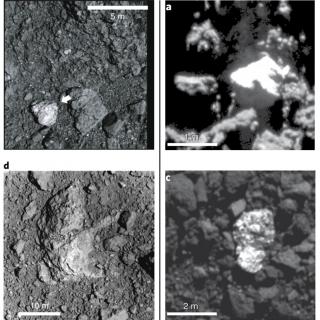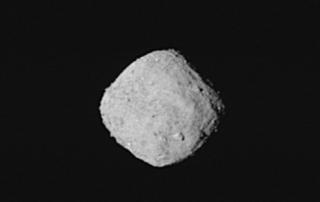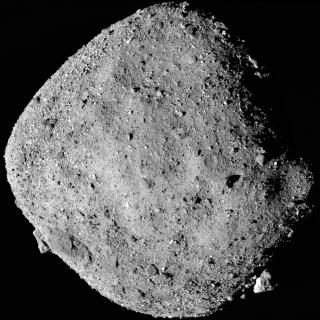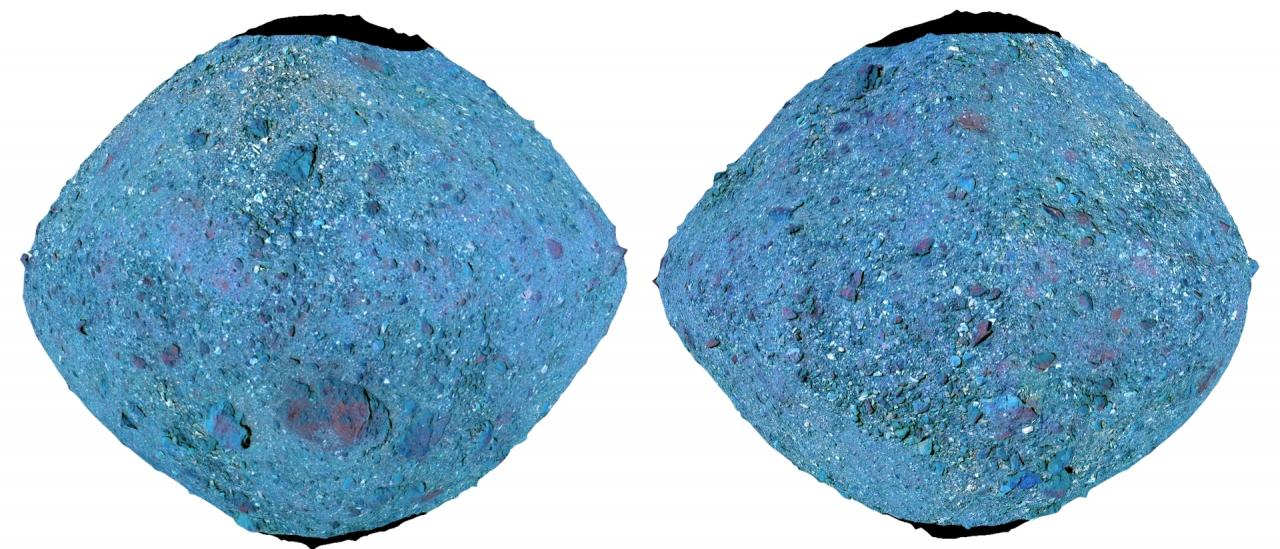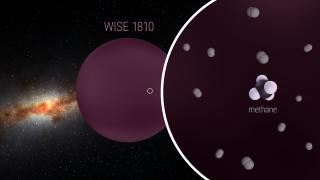Science magazine, in a special collection on asteroid Bennu, has published the results of the analysis of photometric-spectrum color variations on the surface of this extremely interesting asteroid, captured by the NASA OSIRIS-REx spacecraft. Thanks to these results, researchers proposed a model to explain the effects of “space weather” on materials similar to carbonaceous chondrite meteorites. They concluded that some of the heterogeneity observed on the surface of Bennu is due to space weathering and some is inherited from Bennu’s parent asteroid. Juan Luis Rizos, Eri Tatsumi, Javier Licandro and Julia de León, members of the Solar System Group of the Instituto de Astrofísica de Canarias (IAC), have participated in this research.
The main objective of the NASA OSIRIS-REx mission is to collect material from the surface of primitive asteroid (101955) Bennu and bring it back to the Earth. In order to provide context to the results obtained from the analysis of this sample, it is fundamental to carry out an extensive study of the surface of the asteroid. To do that, the spacecraft is equipped, among other instruments, with an optical camera (MapCam) and 4 color filters at visible wavelengths. This set-up allows the researchers to do color studies, i.e., to analyze how the light of the Sun is reflected on the surface of the asteroid at each of these wavelengths or colors. With this information, it is possible to infer the asteroid surface properties, like its rugosity, its porosity, or the size of its particles. It is even possible to know the amount of time the surface has been exposed to the space: cosmic ray interaction, solar wind implantation, and micrometeorite bombardment of the surface of airless bodies modify its properties. All these effects are collectively known as “space weathering”.
“Space weathering effects are well known for the materials present on the surface of the Moon, or in rocky, silicate-rich asteroids, where we observe darkening and reddening of their surfaces with increasing exposure time. However, the effects of space weathering on dark, carbonaceous-like, primitive asteroids like Bennu were still a mystery, in particular considering the contradictory results obtained by laboratory experiments using carbonaceous-like materials”, explains Juan Luis Rizos, researcher at the IAC and and one of the authors of the article.
To measure these effects on the surface of Bennu, the researchers have studied in detail about 1600 boulders and 700 craters, distributed all over the surface of the asteroid. On one side, they have measured color variations within each boulder, analyzing zones with exfoliations and fractures and finding that more recently exposed faces are bluer than average. On the other side, they observed that the smaller craters are redder than average, presenting a size-frequency distribution that indicates they are one of the youngest components of the global crater population.
Space weathering effects
These results have allowed the researchers to propose a mechanism to account for the space weathering effects on this type of materials: “In a first stage, this freshly exposed material is redder than the bulk of Bennu. In a second stage, the amount of opaque materials like magnetite increases, producing a brightening in the ultraviolet region (vivid blueing at short wavelengths). Finally, these color differences are neutralized and the materials get brighter at all wavelengths until they show the less intense blue spectral slope that characterizes Bennu’s global surface”, clarifies Rizos.
Asteroid Bennu is a “rubble-pile” asteroid, i.e., it was formed after gravitational re-accumulation of monolithic fragments. It is believed that these fragments belonged to a parent body of about 100 km in diameter located in the main asteroid belt (between the orbits of Mars and Jupiter) that suffered from a catastrophic impact about 1 billion years ago. The observed albedo variability (i.e., the fraction of light reflected by the surface) in the different structures on the surface of Bennu cannot be explained invoking space weathering.
In addition, other types of heterogeneity are observed: the presence of boulders with colors indicating the presence of iron-bearing phyllosilicates (hydrated silicates), in contrast to a large majority of boulders in which this feature is absent; boulders containing veins of brighter material, which may be composed of carbonates; or even dark boulders having clasts of bright exogenic, basaltic-like material –a finding recently published in Nature Astronomy. “Such heterogeneity can only be explained as a direct heritage from the parent body. We are observing materials that were located at different depths inside that body, and that experienced different aqueous and thermal alteration processes”, indicates Eri Tatsumi, Tatsumi, researcher at the IAC and also a co-author of the study.
The next October 20, 2020, the OSIRIS-REx spacecraft will descend to the surface of Bennu to collect samples of its ground. The selected region is a crater named Nightingale that shows the reddest material as compared to the rest of Bennu. According to the published results “it will be some of the freshest material on Bennu, a time capsule containing a sample that has been little altered since the first stages of the formation of our Solar System, and we are going to bring it to the Earth”, sentences Tatsumi.
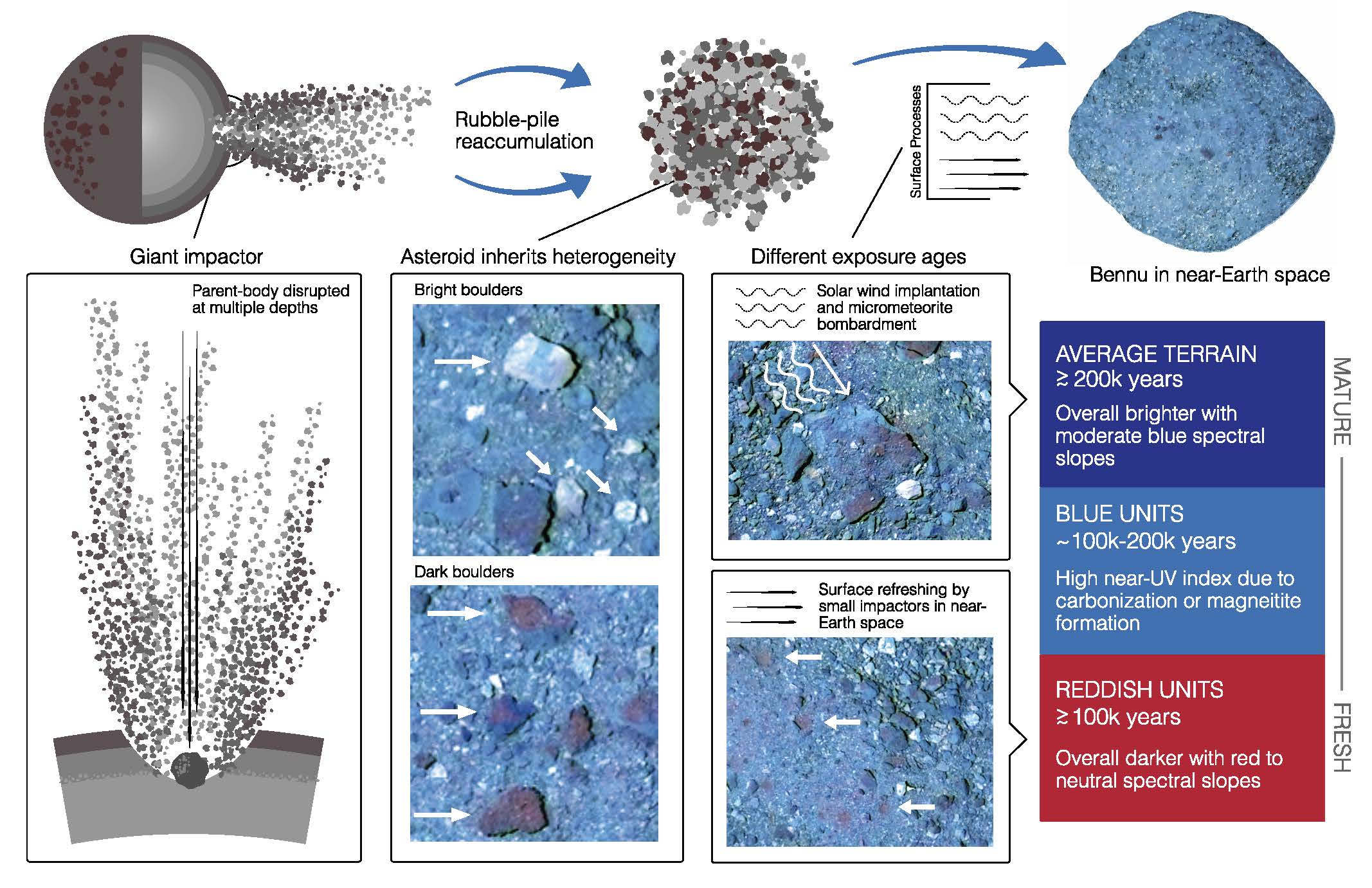
Article: "Variations in color and reflectance on the surface of asteroid (101955) Bennu", DellaGiustina et al., Science Oct 2020, eabc3660, DOI: 10.1126/science.abc3660
OSIRIS-REx Press release: "NASA’s OSIRIS-REx Unlocks More Secrets from Asteroid Bennu"
Contact at the IAC:
Juan Luis Rizos, IAC researcher: juan.rizos [at] iac.es (juan[dot]rizos[at]iac[dot]es)
Eri Tatsumi, IAC researcher: etatsumi [at] iac.es (etatsumi[at]iac[dot]es)

